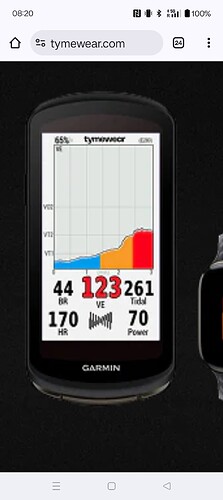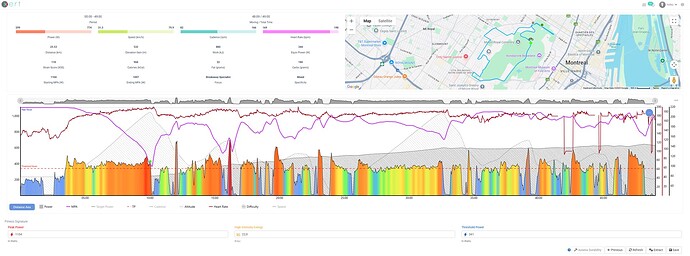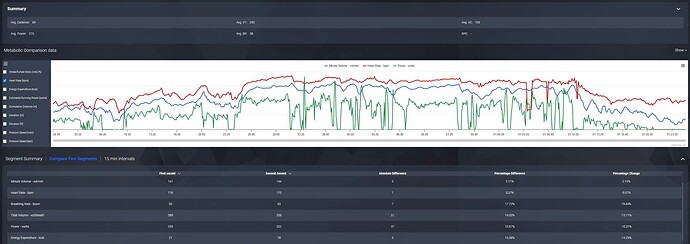Hi,
I’m testing the new VitalPro breathing strap sensor. I only did a couple of rides, including a test to determine training zones. The test determines your VT1 and VT2 zones and Vo2max.
I got an interesting (unexpected) result, but since this is the first test, this may change in the future. It seems my VT1 is low, and VT2 is above what is expected for my age. Since I’m a long-distance rider I would expect to excel in VT1 (which I did in a lab test a couple of years ago).
Xert says my LTP is at 284w, which is close to the test’s result of Z3 290w named Balance Point in Tymeware software. As you know LTP is often called “ride easy” in Xert Magic Buckets to fill the low bucket. According to the test I should focus on VT1, which is only 214w for me.
I’m not trying to compare xert and vitalpro terminology or which is right or wrong. I’m looking to incorporate Vitalpro sensor and VT1 and VT2 metrics into Xert plan. Any insights and discussion would be appreciated.
BTW I noticed Mathieu Heijboer from Jumbo Visma has a coaching account in Xert and Visma is using Vitalpro sensors…
How did you order this? I see it is only available for pre-order.
There was a preorder a few months ago. Prob around May I think? There was a delay due to some last minute hardware change.
I’ve checked the page: it looks like you can still get the first batch if you order before October 31st ![]()
“Ride easy” on XMB is whatever feels easy to you. ![]()
On Endurance day the target is the midline value between 75-100% LTP.
On HIT days it varies but I’ve never seen 100% LTP.
I think respiration rate has the most potential as a viable metric for training purposes since it can be reliably measured in real-time.
But when is altitude factored in? Big difference between sea level and 2500m.
What about a rider’s lung volume? Wouldn’t that be useful to know?
Indeed, not 100% but I often got close to 100% on HIT days during the summer. I suppose Xert was looking to fill my low bucket faster since I was often missing the low XSS due to heat training sessions. Those are done on much lower power zones, but at the same time, you can’t prolong those sessions to meet Xert’s low XSS buckets. I asked on the FB Xert User’s page how to incorporate heat training into the Xert plan, but got no specific answer. Scott shed some light on the topic, but I went with Kelly’s recommendation: “IMO, do what you can on the day. The current system will handle the rest.” For anyone interested, here’s my experience with heat training.
As I understand, the VitalPro sensor has an altitude sensor, so that metric is incorporated into their magic formula for thresholds. Rider’s lung volume is also measured with the strap, although the numbers you see in the post-ride metrics has i.u. units under Tidal Volume, not ml or l. But I guess that’s not important since the difference between the lab test and a test with a Tymewear’s breathing vest a couple of years ago was small.
I’m still far away from a deep understanding of the relationship between power, hr and ventilation. But here’s a simple explanation which we all know from experience, especially if you are a long-distance rider: How to use breathing in training – Tyme Wear™
I did a session today to improve VT1 as suggested by the Tymeware app. This is going to be a loooong winter on a trainer: I was never cold on an indoor bike before ![]()
I got my Vital Pro last week. Too early to judge and they released the strap before the software was ready. It has a few quirks.
That being said, I have found that the test results are pretty close to my Xert zones. And what got me excited was that it’s recommending I do more VO2 training because my other zones are well trained, which matches exactly my Xert program report. I’ve been lagging in HIGH and PEAK . Tired leg syndrome, which unfortunately no platform can measure or take into account. I think the only thing it does “better” than MB is that it takes into account cardiac fatigue and CO2 buildup so your zone may shift higher even though your power output may remain the same or even fade. It would be nice to have the breathing metrics incorporated into the Xert training system.
I’ll give more feedback in a few weeks.
By the way, my strap took four months to arrive…
Thanks for the info. I am also considering buying the sensor.
Do you use the Garmin datafield to adjust the intensity (power) during a ride/workout or do you basically look at the data after the ride?
I use the data field. It changes color depending on the zone. Super useful. It takes a little time to identify spikes that make the zone change. For example grabbing your bottle or blowing your nose. I find it as easy to follow as the power gauge on the magic buckets.
The data after the ride I find confusing. Maybe because I don’t know how to interpret it right now, like power when it came out. They still need to work on the website and the app a bit.
I’m pretty skeptical. What will you do differently with this info? Do you know that riding at or near VT1 is the best way to improve VT1? Does VT1 or LTP feel more like something you can sustain for 2-3 hours, but will get to be pretty difficult?
I’ve got one on order and hope it will identify in real time when I’m going consistently over VT1 on my long rides. I find it very difficult to judge what is “easy” in real time and I suspect I’m spending a lot more time over VT1 than I think I am, leading me to be fatigued a lot more than I think I should be.
I also like shiny new things ![]()
I have also tried to find some screenshots of the Garmin datafields and the phone app without much success. I guess they are still improving those, but if someone could share some screenshots that would be nice.
I am not sure how to use this in real time. Will the power required to be at LT1 normally change significantly during a ride? Will I basically use this to make sure I stay just below LT1 on easier days because going higher will only make me tired with minimal extra training effect? And the same with LT2?
That is my understanding. I’ve listened to some podcasts where Stephen Seiler has spoken about how at constant watts the minute ventilation stays the same but the breathing rate starts to increase after a certain (and very individual) amount of time until what started out as low intensity ride ends up as tempo. The garmin app should show this happening in real time.
I did a race on TPV on Wednesday. It was a iTT with two laps and two short climbs. I was highly motivated compared to a ramp test I did with Vital Pro strap to determine the VT zones: I left nothing on the table.
What I would like to compare is Xert’s interpretation of this wo vs VitalPro interpretation. Here are the charts:
I have recorded the wo on two devices since TPV doesn’t support VitalPro yet. Accordingly, there’s no elevation profile on the second chart, but the two segments are the ascents. Also the second chart has warm-up period while Xert’s starts recording a couple of min before the start.
Xert chart tells me I did BT on first climb (which I did the 3rd time in a row in the last three days but not my season high) and I was way behind on second attempt of the same climb. Note the MPA. Difficulty on the end of the first climb was 44 and on the second 107.
Now check the data for the two segments on the second chart. My power on the second attempt is 37watts lower, and MPA says I could still hit 770w for 5 sec on top of the climb. Check my effort on live stream and tell me: sure you could do that ![]() https://www.youtube.com/live/pQ5kmcNUvLw?si=4FTrjgJUmEVtL0HR&t=1890
https://www.youtube.com/live/pQ5kmcNUvLw?si=4FTrjgJUmEVtL0HR&t=1890
What bothers me with Xert is the Durability score, which you can only assess for wo longer than 2h, and you need an effort to exhaustion to make it work. And still you can’t use it during the ride. It’s post-event analyses.
However VitalPro chart summarises what I really felt during the second climb. With the same HR and just 2% higher Minute Volume VE my Breathing Rate BR went up for almost 18% and Tidal Volume TV for 14%. At the same time power drop was almost 11%.
According to Tymewear papers, Minute Ventilation is considered a consistent indicator of your true training intensity, and in lab tests, this is what was found:
*The Tymewear VitalPro is a wearable chest strap that measures ventilation and heart rate, designed to capture breath-by-breath ventilation signals during exercise. This study validates the VitalPro against the Cosmed K5 metabolic cart—a gold-standard tool for metabolic and ventilatory assessment—for continuous respiratory metrics including breathing rate (BR) and minute ventilation (VE). BR measurements from the VitalPro demonstrated high agreement with Cosmed data with a mean absolute error (MAE) of 1.2 breaths per minute. Minute ventilation also showed a strong pooled correlation (r = 0.973, r² = 0.947). These results support the use of the Tymewear VitalPro as a reliable tool for field-based respiratory performance monitoring.
So VitalPro tells me I was actually doing harder work on the second climb while Xert suggests there’s still room for increased effort. Xert’s Difficulty suggests I was working harder, though but I’m 100% sure I was not able to meet the MPA suggested.
I guess VitalPro gives you live data vs Xert’s durability score, which is useful after the fact under certain conditions. If I could meet those conditions, Xert would get me similar results?
But the real value of the strap lies in the way you can measure your efforts on long rides below your max or exhaustion efforts. As a long-distance rider, I have stated this many times: MPA just doesn’t show your fatigue after 8h of Z1 or Z"2 in the saddle. You are supposed to be able to hit your MPA just like you should be able to hit it after 15 minutes of warmup. Yes, I can assess the Durability score, but I still need all-out effort and check the data later in the analysis.
Another benefit of the strap is it can show you your weaknesses. I’m lagging behind with long distance rides (the opposite what @bikingviking experience with the strap) since I was doing a lot of hard efforts over the summer following Xert suggestions. And it yielded great results. However if I had set new plans, Xert would continue to suggest HI intervals and I would hit the dreaded plateau since my Vo2 is overdeveloped and I need to focus on Z1 before I can lift the intensity again.
It would be great if @xertedbrain and @ManofSteele can shed some light on the topic as I might interpret the charts wrong here.


